This is my review of the new US$115 UltraStudio 3G Recorder interface, which supersedes the prior UltraStudio Recorder, which is not 3G. Blackmagic lent it to me for this review and I already returned it. The 3G portion and the Thunderbolt 3 connection give the new version greater features, such as more video formats, greater selection of color space, RGB video formats and lower price of only US$115 instead of US$145. Ahead are more details, photos, screenshots, what I like and what I wish it might do with future software/firmware updates.
“UltraStudio Recorder 3G lets you work anywhere because they are extremely compact and are powered from the Thunderbolt 3 connection,”
said Grant Petty, CEO, Blackmagic Design.
“You can simply plug into any Thunderbolt 3 enabled laptop or a desktop computer and start working. With support for high bandwidth formats up to 1080p60 these are advanced video capture and playback solutions that are small enough to fit in your pocket. There is nothing more portable!”
Please note that although 1080p60 mentioned by Grant Petty is common among video gamers, the closest standard rate for conventional broadcast is ≈59.94 which is also supported by the UltraStudio Recorder 3G, as well as lower rates like (in descending order) 50, ≈29.97, 25, 24 and ≈23.976. On top of that, it also supports 1080PsF25 and 1080PsF≈29.97 via the SDI input, although not currently via the HDMI input.
Additional UltraStudio Recorder 3G features:
- High-speed Thunderbolt 3 port for high quality video processing.
- Built in 3G-SDI and HDMI connections .
- Uncompressed and compressed 10-bit 4:2:2 YUV or RGB quality.
- Supports DaVinci Resolve and all other video software.
- Developer SDK available to download free.
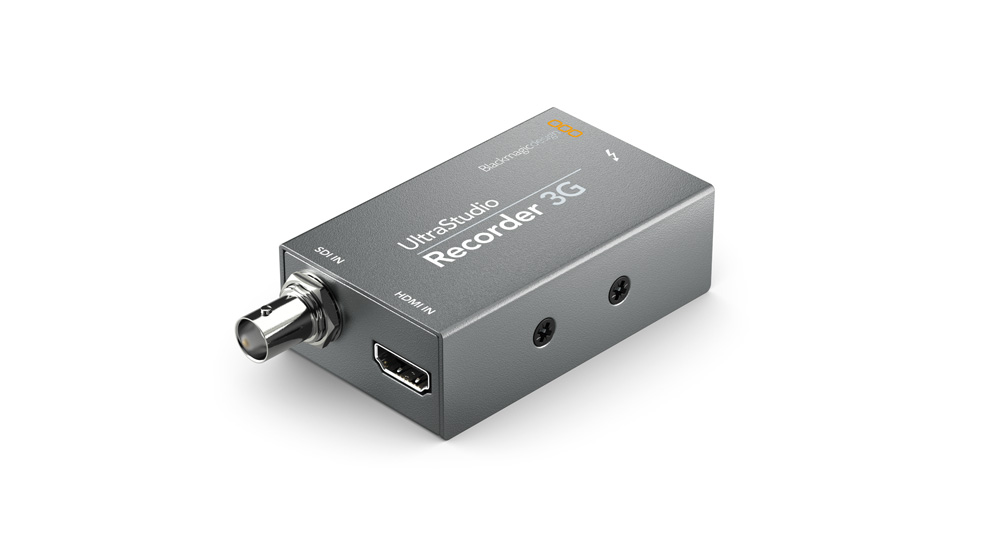
Initial, main purpose of the UltraStudio Recorder 3G
The initial, main purpose of the UltraStudio Recorder 3G is (like its predecessor) to get an HDMI or SDI video signal into a computer. With the original version, it connects via the first Thunderbolt. The new UltraStudio Recorder 3G connects via Thunderbolt 3.
As stated earlier, the main improvements are more input formats. The ones that were most interesting to me are the PsF capabilities (which potentially might alleviate type 1 camera shyness in a live streaming situation, as reviewed ahead) and higher framerates in 1080p (which can alleviate type 3 shyness in a live streaming situation), as reviewed ahead).
Refresher about the three types of “shy” 1080p camera situations
There are three types of 1080p shyness in cameras, in order of importance: PsF, Telecine and Doubling.
Type 1: PsF (progressive segmented frame)
I am separating PsF (progressive segmented frame) into three subcategories:
- When the shy camera is set to image (and sometimes also to record internally) with a common progressive framerate (in ex NTSC regions) like ≈29.97p, it sadly outputs the signal as PsF (progressive segmented frame), in other words, disguised as ≈59.94i. To be more specific, it takes each progressive frame and segments it into two artificial fields, each with half of the original pixel resolution and each with 540 intertwining lines to add up to the original 1080. Unlike true 1080i —where each field can potentially have different temporal (time) information when there is movement, with PsF the temporal information of each artificial field is always identical.
- Similarly, when the shy camera is set to image (and record internally) with a common progressive framerate (in ex PAL regions) like ≈25p, it sadly outputs it the signal as PsF (progressive segmented frame), in other words, disguised as 50i.
- The third PsF case is very rare nowadays and never happens with HDMI, but only with some SDI and with very expensive cameras, where with the ≈23.976p (aka ≈23.98p) rate the camera sadly outputs the signal as PsF (progressive segmented frame), in other words, disguised as 47.952. (In the case of HDMI, shy 1080p cameras in ≈23.976p use a telecine method with a 2:3 (aka 3:2) pulldown explained ahead.) This rare case is outside the scope of this article.
Type 2: Telecine with pulldown
To make the ≈23.976 fit in a more standard ≈59.94i television rate, telecine performs a complex assignment to make pieces of the original frames “fit” into ≈59.94 fields, some of which contain the same temporal information and others don’t.
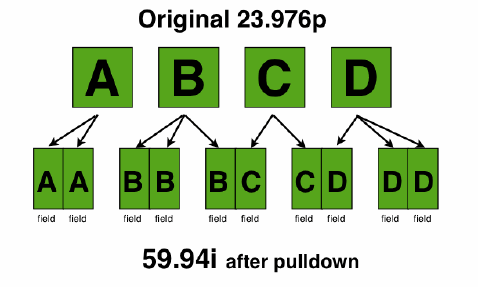
This is illustrated in the above graphic, which I created in 2008 to illustrate my very first article in ProVideo Coalition magazine. The instructions for the pulldown (i.e. “Put the first progressive frame in both fields of the first interlaced video frame. Now, put the second progressive frame in both fields of the second video frame in the first field of the third video frame, then…”) seem as twisted as the Twister game which dates back to 1966.
Type 3: Doubling of progressive frames per second
When set to image and record ≈29.97p, some shy 1080p cameras duplicate the number of frames per second to ≈59.94 progressive frames per second on the HDMI or SDI output. Similarly, when set to image and record 25p, they duplicate the output framerate to 50 progressive frames per second over HDMI or SDI. As long as your hardware can accept high progressive framerates like 1080/50p and 1080/≈59.94p (i.e. more recent models like the UltraStudio Recorder 3G, ATEM Mini, ATEM Mini Pro, ATEM Mini Pro ISO), this is the easiest type of shyness to solve, and doesn’t require the video mixer (“switcher”) developers/manufacturers to do anything special, as several already have at my request to properly resolve PsF and telecine while retaining all of the original image quality. To solve this, the user/operator should simply set the camera menu and the session in the video mixer for the desired delivery framerate (1080/25p or 1080/≈29.97p) and the mixer will simply skip half of the repeated progressive frames per second.
No luck yet for having the UltraStudio Recorder 3G alleviate type 1 or type 2 shyness live for now
Although I have published many articles about how to deal with type 1 and 2 camera shyness in post-production, I was hoping that the UltraStudio Recorder 3G might also help alleviate at least type 1 shyness live, on the fly.
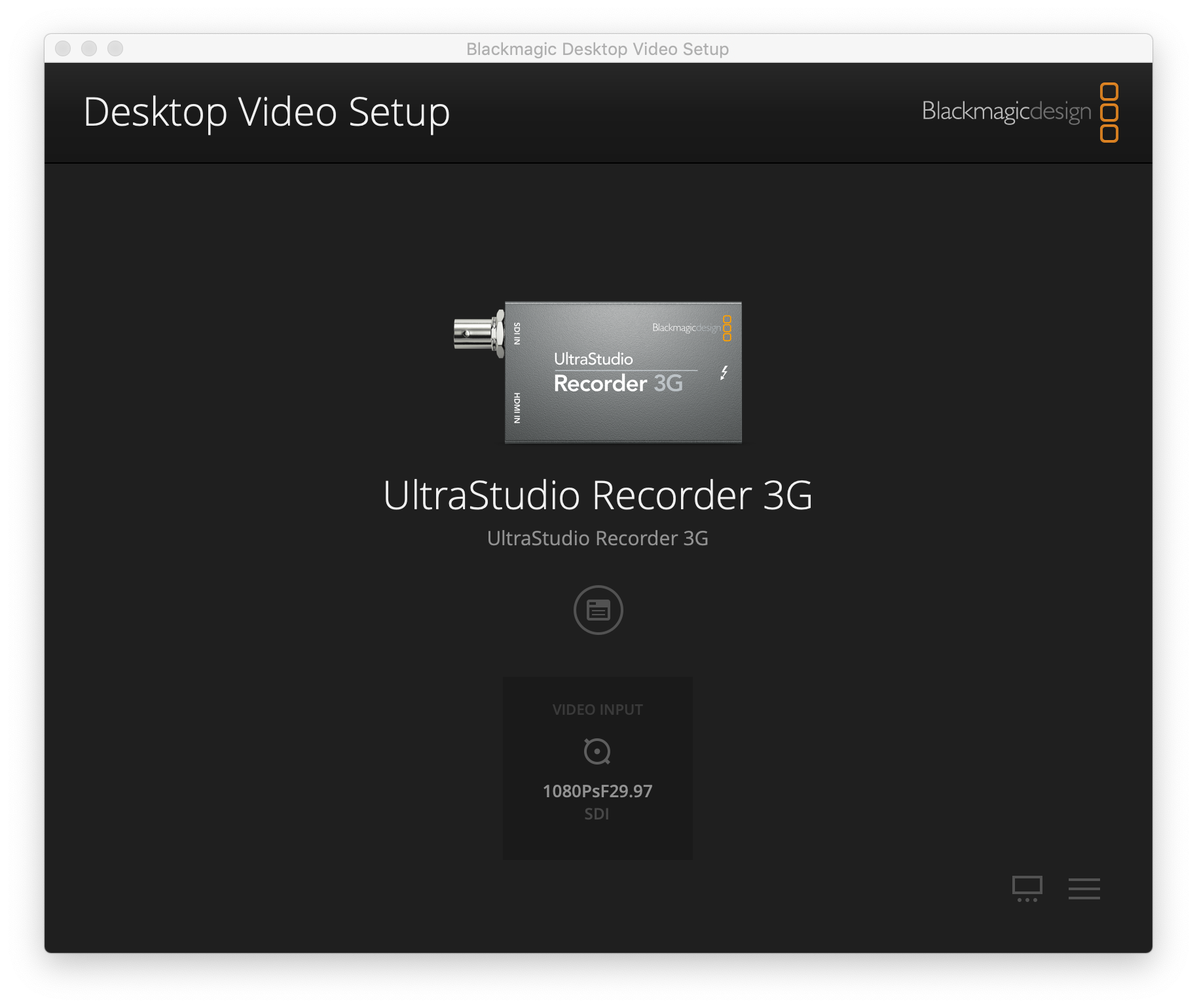
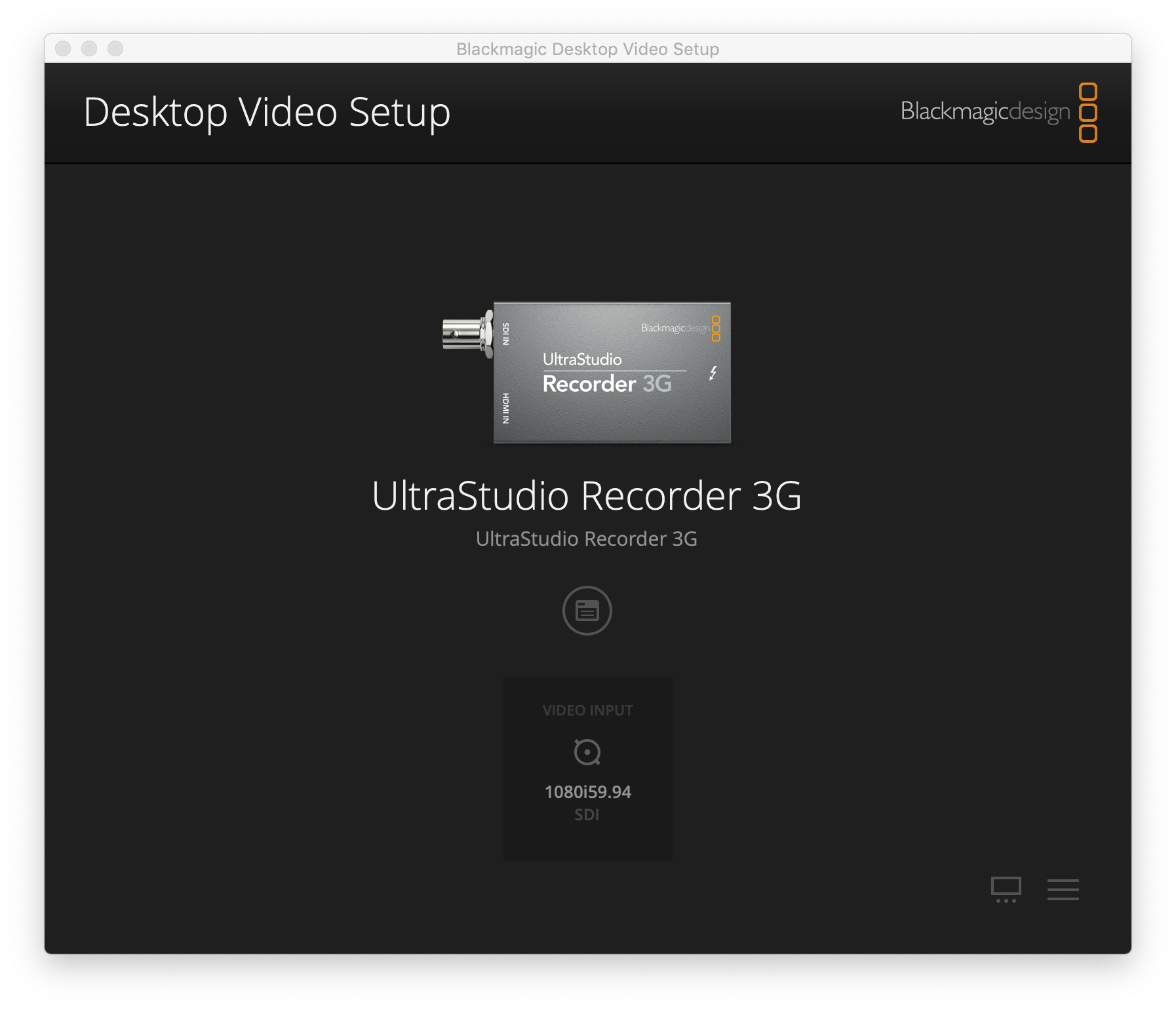
In my testing, I confirmed that the UltraStudio Recorder 3G together with the latest Desktop Video app can indeed receive and properly identify a PsF signal like 1080PsF≈29.97 as indicated in the first of the two screenshots above. (Over HDMI there is no PsF flag so it just sees it as 59.94i as seen in second screenshot above.) However, neither the UltraStudio Recorder 3G nor the Desktop Video app currently has any function to convert that PsF signal into pure progressive, which is what we really want to achieve. Blackmagic responded that this is up to the receiving app. As already confirmed by developers like Ecamm (creator of the wonderful Ecamm Live app, which I have covered in many articles), that function is not in their software either and likely will never be there. As a result, a program like Ecamm Live most likely takes only a single field and therefore only gets the equivalent of 1920×540 true pixels rather than the full 1920×1080 progressive signal that the camera actually imaged.
How the UltraStudio Recorder 3G indirectly helps to alleviate type 3 camera shyness
If you use a camera like the PXW-X70 and many other Sony cameras that suffer from type 3 shyness and you set the camera to shoot at 1080p25, although it properly records internally as desired, on its HDMI and SDI output, it doubles the framerate to 1080p50.
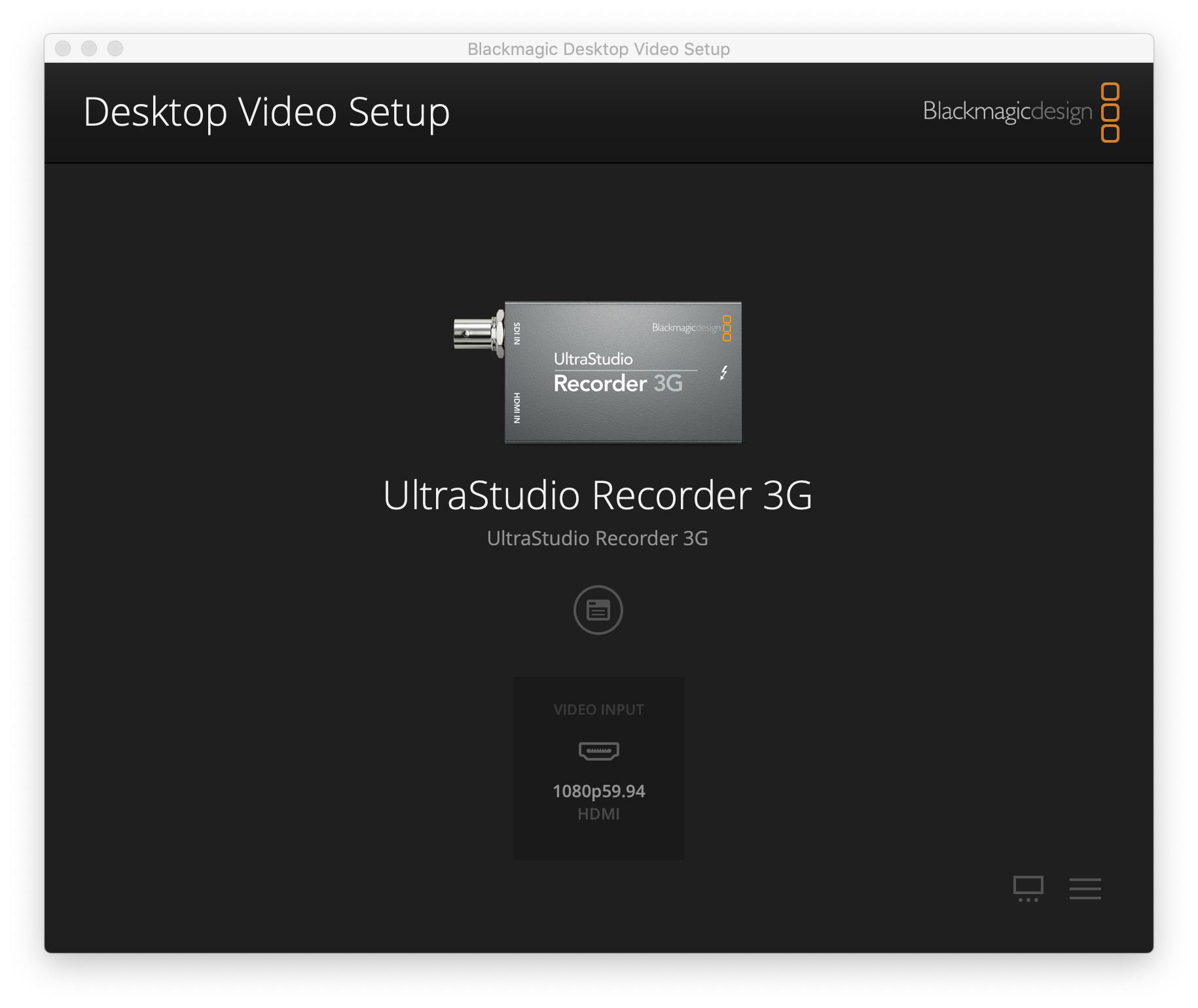
Similarly (as indicated above), if you set the camera to shoot at 1080p≈29.97, it outputs 1080p≈59.94 (double, but fortunately still progressive) over its SDI and HDMI output.
This is properly identified in the above screenshot taken from the Desktop Video app through the UltraStudio Recorder 3G.
Although the combination of the UltraStudio Recorder 3G and the Desktop >Video app doesn’t currently offer any way to deliver only half of the incoming frames, it is very easy for an app like Ecamm Live to use only half of them. Unlike the more daunting task of reintegrating fake video fields into their original pure 1920×1080 frames, all Ecamm Live needs to do (after we set the desired streaming rate to 25 FPS or what is currently called in the Ecamm Live menu as “30 FPS”. (This should really either be ≈29.97 FPS if Ecamm Live streams at CFR ir ≈30 FPS if Ecamm Live streams at VFR.) In any case, by telling Ecamm Live the desired framerate, all is solved quite simply.
This solution was not an option with the original UltraStudio Recorder since it did not except higher framerate 1080p signals. This is one way that the new UltraStudio Recorder 3G can help with a camera that suffers from type 3 camera shyness. So it’s a great solution for the PXW-X70 but not helpful with the FS7 at these framerates, since the FS7 suffers from type 2 shyness, not type 3.
Thanks to Diego, Francisco Javier and Memo
- Thanks to Diego Pocoví for lending him his SDI cables for this test.
- Thanks to Francisco Javier for lending me his shy Sony PXW-X70 camera for this test.
- Thanks to Memo Sauceda for allowing me to use his MacBook Pro with Thunderbolt 3 input and also the shy Sony FS7 camera which Memo had rented for a shoot at the same time as I was doing these tests.
Conclusions
What I like about the UltraStudio Recorder 3G
- Good build quality
- Self-powered over the Thunderbolt 3 connection
- High framerate 1080p capabilities for both true high framerate or to alleviate type 3 camera shyness
Precautions
- To my knowledge, the UltraStudio Recorder 3G is limited in its hardware not to include any type of 4K signal.
- No cables are included.
Wishes to be added via future software and/or firmware updates
- Have the Video Desktop app re-create 1080p from 1080PsF on-the-fly to alleviate type 1 shyness (processor dependent).
- Have the Video Desktop app perform reverse telecine from 1080p footage which has ≈23.976p over ≈59.94p with a 2:3 (3:2) pulldown on-the-fly and deliver 23.976p to other apps, to alleviate type 2 shyness (processor dependant).
See also my recent article Blackmagic + NewTek: conspiracy theory with shy cameras.
Stand by for upcoming articles with yet other solutions to resolve camera shyness in the era of live streaming by staying on my free mailing list.
(Re-)Subscribe for upcoming articles, reviews, radio shows, books and seminars/webinars
Stand by for upcoming articles, reviews, books and courses. Sign up to my free mailing list by clicking here. If you previously subscribed to my bulletins and no longer receive them, you must re-subscribe due to new compliance to GDPR. Most of my current books are at books.AllanTepper.com, and my personal website is AllanTepper.com. Also visit radio.AllanTepper.com.
Si deseas suscribirte (o volver a suscribirte) a mi lista en castellano, visita aquí. Si prefieres, puedes suscribirte a ambas listas (castellano e inglés).
Suscribe to my BeyondPodcasting show in English or CapicúaFM en castellano.
FTC disclosure
No manufacturer is specifically paying Allan Tépper or TecnoTur LLC to write this article or the mentioned books. Some of the other manufacturers listed above have contracted Tépper and/or TecnoTur LLC to carry out consulting and/or translations/localizations/transcreations. Many of the manufacturers listed above have sent Allan Tépper review units. So far, none of the manufacturers listed above is/are sponsors of the TecnoTur , BeyondPodcasting CapicúaFM or TuSaludSecreta programs, although they are welcome to do so, and some are, may be (or may have been) sponsors of ProVideo Coalition magazine. Some links to third parties listed in this article and/or on this web page may indirectly benefit TecnoTur LLC via affiliate programs. Allan Tépper’s opinions are his own. Allan Tépper is not liable for misuse or misunderstanding of information he shares.
Copyright and use of this article
The articles contained in the TecnoTur channel in ProVideo Coalitionmagazine are copyright Allan Tépper/TecnoTur LLC, except where otherwise attributed. Unauthorized use is prohibited without prior approval, except for short quotes which link back to this page, which are encouraged!

Filmtools
Filmmakers go-to destination for pre-production, production & post production equipment!
Shop Now












